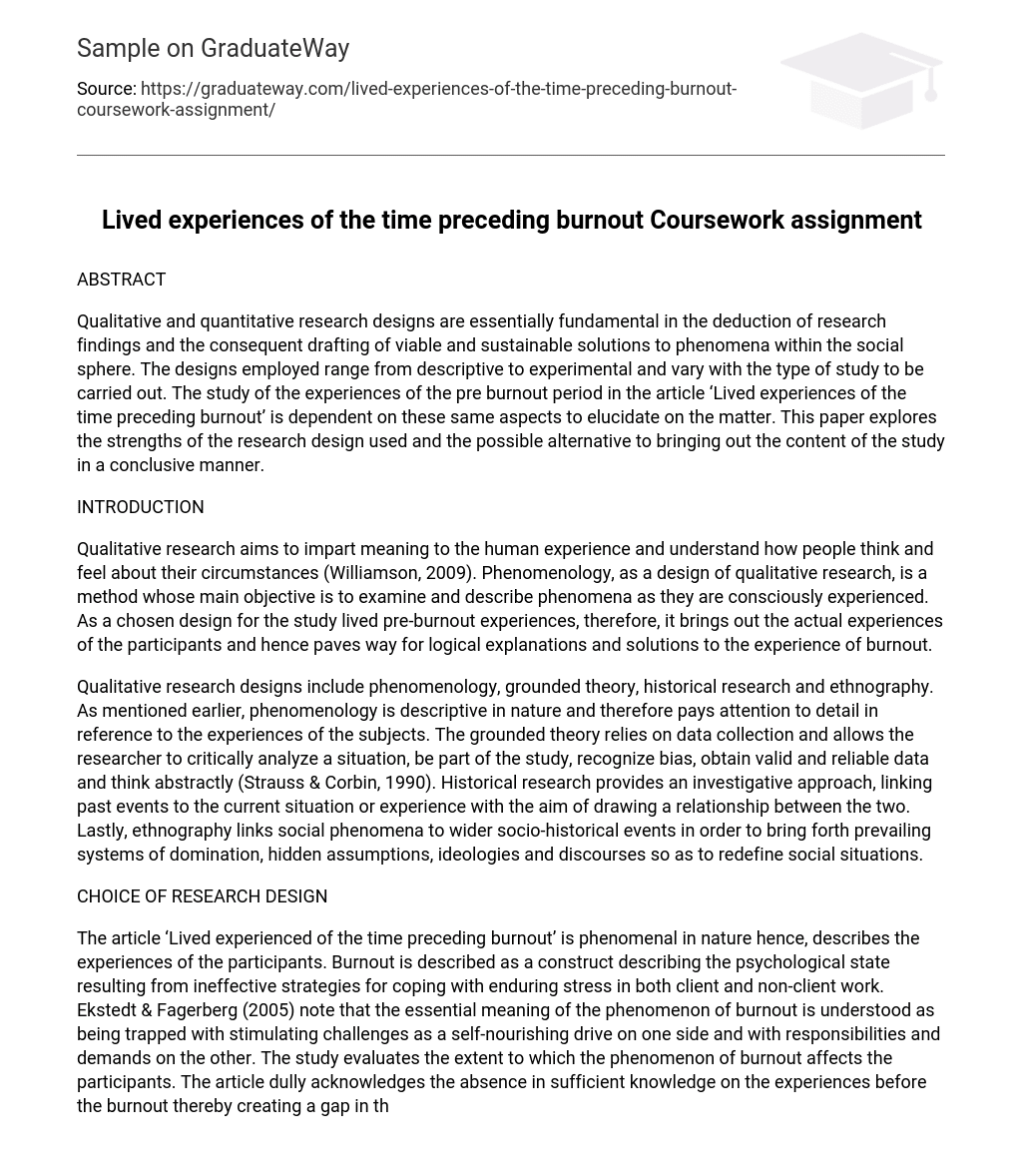ABSTRACT
Qualitative and quantitative research designs are essentially fundamental in the deduction of research findings and the consequent drafting of viable and sustainable solutions to phenomena within the social sphere. The designs employed range from descriptive to experimental and vary with the type of study to be carried out. The study of the experiences of the pre burnout period in the article ‘Lived experiences of the time preceding burnout’ is dependent on these same aspects to elucidate on the matter. This paper explores the strengths of the research design used and the possible alternative to bringing out the content of the study in a conclusive manner.
INTRODUCTION
Qualitative research aims to impart meaning to the human experience and understand how people think and feel about their circumstances (Williamson, 2009). Phenomenology, as a design of qualitative research, is a method whose main objective is to examine and describe phenomena as they are consciously experienced. As a chosen design for the study lived pre-burnout experiences, therefore, it brings out the actual experiences of the participants and hence paves way for logical explanations and solutions to the experience of burnout.
Qualitative research designs include phenomenology, grounded theory, historical research and ethnography. As mentioned earlier, phenomenology is descriptive in nature and therefore pays attention to detail in reference to the experiences of the subjects. The grounded theory relies on data collection and allows the researcher to critically analyze a situation, be part of the study, recognize bias, obtain valid and reliable data and think abstractly (Strauss & Corbin, 1990).
Historical research provides an investigative approach, linking past events to the current situation or experience with the aim of drawing a relationship between the two. Lastly, ethnography links social phenomena to wider socio-historical events in order to bring forth prevailing systems of domination, hidden assumptions, ideologies and discourses so as to redefine social situations.
CHOICE OF RESEARCH DESIGN
The article ‘Lived experienced of the time preceding burnout’ is phenomenal in nature hence, describes the experiences of the participants. Burnout is described as a construct describing the psychological state resulting from ineffective strategies for coping with enduring stress in both client and non-client work. Ekstedt & Fagerberg (2005) note that the essential meaning of the phenomenon of burnout is understood as being trapped with stimulating challenges as a self-nourishing drive on one side and with responsibilities and demands on the other. The study evaluates the extent to which the phenomenon of burnout affects the participants. The article dully acknowledges the absence in sufficient knowledge on the experiences before the burnout thereby creating a gap in the actual analysis of pre-burnout experiences of the participants.
The choice of design for this particular study was valid in bringing out the situation. Due to the fact that phenomenology allows the study of conscious experiences, the study brings out the individual situations of the participants right down to the effects burnout has had on each of them. However, the phenomenological research design is limited in that it does not seek the root causes of the issue and therefore may not come up with sustainable solutions.
ALTERNATIVE QUALITATIVE RESEARCH DESIGN
There are five basic steps towards achieving a conclusive qualitative research study. The first step deduces the primary etic record of the situation and appeal to the researcher’s etic perspective. The next step is generate dialogical data then describe the system’s relation to broader context and finally to explain relational systems.
The results of the study would have been brought out more clearly if the design employed was ethnography, which in essence links social phenomena to socio-historical events and brings out the explanation of system relations.
The advantage of using this design is that it helps the researcher (s) remain focused on the importance of seeking explanations for social behavior and compare observed and said results and the meanings generated from the researcher-participant encounter. Ethnography would have further allowed a look into the past trends and linkages to the current issue and hence draw viable solutions. Lived experiences preceding burnout could be as a result of a trend within the participants’ personal or professional lives that may or may not interlink between participants.
CONCLUSION
The research method a researcher chooses to employ is dependent on the intended outcome and the purpose for which the study is conducted. This particular one hinged on the possibility of understanding the trends that lead to and the solutions to the issue of burnout among the working class adults used as participants herein. In future, similar studies may call for the employment of a different design or a merger of the qualitative or quantitative research designs for a more conclusive result base.
References
- BECK, C. T. (1992). The lived Experience of Postpartum Depression: A Phenomenological Study
- Beck, C. T. (2002). Postpartum Depression: A Metasynthesis. Vol. 12 No. 4. SAGE Publications
- Beck, C. T. (1993). Teetering on the Edge: A Substantive Theory Of Postpartum Depression. Vol. 42 No. 1
- Ekstedt M., & I. Fagerberg (2005). Lived Experiences of the Time
- Preceding Burnout. Journal of Advanced Nursing 49(1), 59–67
- Hardcastle, M., K. Usher & C. Holmes (2006). Carspecken’s Five-Stage Critical Qualitative Research Method: An Application to Nursing Research. Vol. 16 No. 1. SAGE Publications
- Williamson, K. M. (2009). Evidence-Based Practice: Critical Appraisal of Qualitative Evidence. Journal of the American Psychiatric Nurses Association. Vol. 15 No. 3. SAGE Publications
- Strauss, A., & Corbin, J. (1990). Basics of qualitative research: Grounded theory procedures and techniques. London: Sage Publications.





